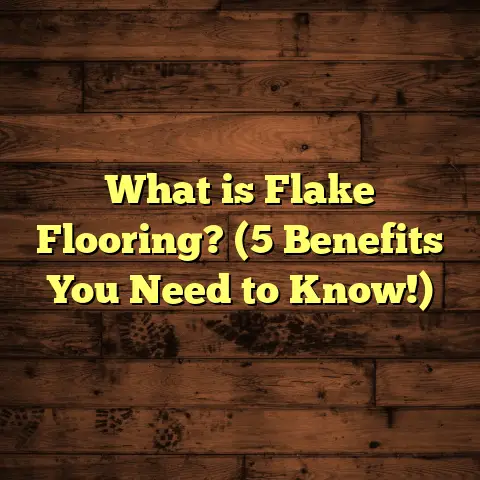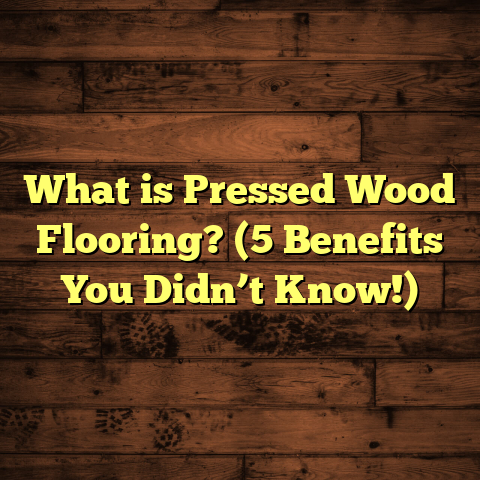What is Congoleum Flooring? (5 Key Benefits for Homes)
Healthier homes start with smarter choices, especially when it comes to flooring. Over the years, I’ve learned that the floor you pick can significantly affect your family’s health, comfort, and even mood. When I first heard about Congoleum flooring, I was curious if it could really make a difference beyond the obvious looks and durability. After working with it extensively and seeing the real-life impacts, I’m convinced that it deserves a spot on anyone’s list when considering new floors.
So, what exactly is Congoleum flooring? How does it stack up against all the other options out there? And why might it be a great fit for your home? Let’s spend some time breaking all of this down, sharing my personal experiences, industry data, and insights gathered from years of flooring projects.
What is Congoleum Flooring?
Congoleum flooring is a type of resilient vinyl flooring that has been around for over a century. What sets Congoleum apart is its unique manufacturing process and composition. Unlike traditional linoleum or standard vinyl flooring, Congoleum combines a cork dust base with multiple layers of vinyl and resin to create a tough yet flexible surface.
The cork dust base adds durability and resilience, while the vinyl layers provide water resistance and design versatility. This combination results in a floor that can endure high traffic and resist many common types of damage, such as scratches, stains, and dents.
Congoleum is offered in both sheet and tile formats. The sheet versions are ideal for large areas and provide a seamless look, while tile options give more flexibility in design and are often easier to install as DIY projects.
One thing that stood out to me early on was how Congoleum manages to blend strength with style. The product line has evolved dramatically from its early days when linoleum was considered old-fashioned. Today’s Congoleum floors feature sophisticated patterns and textures that mimic natural materials like hardwood, stone, and ceramic tile.
A Quick History Lesson
Congoleum’s roots go back to the early 1900s when linoleum was widely used as an affordable durable floor covering. As technologies advanced, Congoleum developed its own version of resilient flooring based on vinyl polymers instead of linseed oil-based linoleum.
This shift allowed for more color options, better water resistance, and longer-lasting performance. Over the decades, Congoleum has remained a trusted name in commercial and residential floors alike.
I remember chatting with a local flooring historian once who pointed out that many older homes with original Congoleum floors still have them intact—testament to the product’s impressive longevity.
1. Health Benefits: Cleaner Air and Safer Homes
When I first started installing floors in clients’ houses years ago, one of the biggest concerns they raised was health—specifically allergies and indoor air quality. Carpets often trap dust mites, pet dander, pollen, and other allergens that can make life miserable for people sensitive to these irritants.
Congoleum flooring provides a healthier alternative because its surface is non-porous and smooth. This means allergens have nowhere to hide. Regular sweeping or vacuuming easily removes dust and debris rather than letting it settle deep into fibers like carpet does.
Allergy Reduction
Studies have shown that hard surface floors like vinyl or wood tend to have significantly lower allergen levels than carpeted rooms. The American College of Allergy, Asthma & Immunology notes that hard flooring reduces exposure to allergens compared to carpet.
I saw this firsthand when I installed Congoleum in a family’s home who had two children with severe asthma. Their previous carpet had been harboring allergens that triggered frequent attacks. After switching to Congoleum floors throughout their living areas, they reported fewer episodes and noticeable improvement in breathing comfort within weeks.
Mold and Moisture Resistance
Another health-related benefit is moisture resistance. Mold thrives in damp environments and can exacerbate respiratory issues. Congoleum’s vinyl layers make it highly resistant to water penetration.
I’ve installed this flooring in basements and bathrooms where moisture control is critical, and it holds up well without warping or encouraging mold growth underneath. This makes it safer than many hardwood or laminate floors which can absorb moisture over time.
Low VOC Emissions
Indoor air quality is also affected by chemical emissions from building materials. VOCs (volatile organic compounds) are chemicals released into the air from products like paints, adhesives, and some flooring materials.
Many Congoleum products are certified low-VOC or meet strict indoor air quality standards such as FloorScore® certification. This means they emit fewer harmful chemicals into your home environment compared to many other vinyl or laminate options.
This point matters especially if you have young children or anyone with chemical sensitivities in your home. When I recommend flooring to clients with these concerns, I always highlight these certifications as part of making a safer choice.
Summary of Health Benefits:
- Non-porous surface reduces allergen buildup
- Resistant to moisture helping prevent mold growth
- Low VOC emissions improve indoor air quality
- Easier cleaning reduces dust accumulation
If you or your family struggle with allergies or asthma, consider these health advantages when choosing your next floor.
2. Durability: A Floor That Keeps Up With Life
A floor needs to hold up under pressure—whether from kids running around, pets scratching, furniture being moved, or just everyday foot traffic. This is where Congoleum really shines.
I’ve seen many floors crack, dent, or wear out quickly after only a few years in high-use areas. But Congoleum’s unique layered construction offers impressive durability that often outperforms other resilient floors.
Scratch and Scuff Resistance
The top layer of Congoleum is treated with a high-performance finish that provides strong resistance against scratches and scuffs. This means you can drop toys or move chairs around without worrying about permanent marks.
In one project at a daycare center I worked on, the floor had to withstand constant activity from children’s play. After several years of heavy use, the Congoleum floor showed minimal signs of wear compared to other areas with laminate or vinyl tiles nearby.
Stain Resistance
Another durability factor is resistance to stains from spills like wine, coffee, or oils. The smooth surface doesn’t absorb liquids easily, so stains wipe right off without special cleaners or harsh chemicals.
I recall a client who spilled red wine on their kitchen floor during a dinner party. They were amazed at how easily it cleaned up without leaving any discoloration—a quick mop was all it took!
Impact Resistance
Thanks to the cork dust base layer beneath the vinyl surface, Congoleum offers some shock absorption while remaining firm underfoot. This helps prevent dents from dropped objects or heavy furniture legs.
This combination of firmness with slight cushioning also makes it more comfortable to stand on for long periods compared to harder surfaces like ceramic tile.
Longevity Backed by Data
According to tests by third-party labs and manufacturer reports:
- Congoleum can resist abrasion 10 times better than typical vinyl sheets
- It maintains structural integrity under heavy rolling loads (like office chairs)
- It resists common household chemicals including bleach and acids
Homes with installed Congoleum floors often report 20+ years of service life without replacement or refinishing—significantly longer than average laminate or carpet replacements which typically need renewal every 10-15 years.
3. Style and Design: Beauty Without Compromise
You might wonder if a resilient vinyl floor like Congoleum can truly look good enough for your home’s style. From my experience working with hundreds of clients, the answer is yes—and then some.
The perception that vinyl floors look cheap or plastic has changed drastically over the last decade thanks to advances in printing technology and design innovation.
Variety of Looks
Congoleum offers a huge range of designs including:
- Wood grains mimicking oak, maple, hickory, and more
- Stone looks replicating slate, marble, travertine
- Classic patterns like geometric tile effects or terrazzo
Each design uses high-resolution photographic layers combined with textured embossing to create realistic depth and feel underfoot.
One time, a client who preferred hardwood wanted something more budget-friendly but still authentic-looking for their open-concept living room. We chose a hand-scraped wood design in Congoleum plank format that fooled even their friends into thinking it was real hardwood.
Color Options for Every Taste
Whether you like warm earthy tones or cool contemporary shades, there’s likely an option in the Congoleum palette. From subtle grays and beiges to rich browns and blacks—the choices cover nearly every interior style.
I’ve helped homeowners coordinate Congoleum floors with wall colors, cabinetry finishes, and furniture styles by providing samples so they could see how lighting affected color perception in their space.
Customization Potential
For those wanting something unique, Congoleum also offers customizable patterns where different colors or motifs can be combined for bespoke designs.
This level of personalization makes it ideal for creative homeowners who want floors that reflect their personality without overspending on exotic natural materials.
4. Installation & Maintenance: Making Life Easier
Choosing flooring often comes down to practical concerns about installation hassle and ongoing upkeep—things I hear about constantly from clients trying to balance budget and time constraints.
Congoleum scores well here too because it’s designed for relatively straightforward installation and simple maintenance routines.
Installation Types
Congoleum comes mainly in two formats:
- Sheet Flooring: Large rolls glued down over prepared subfloors create a seamless surface ideal for kitchens, bathrooms, basements
- Tiles/Planks: Often available with click-lock systems making them easier for DIYers to install without glue
Sheet flooring installation usually requires professional expertise because the subfloor must be very smooth and clean to avoid imperfections showing through.
Tiles/planks offer flexibility for smaller rooms or spaces where you want easier future replacement options if needed.
Subfloor Preparation
A common question I get: “Do I need special subfloor prep?” For best results:
- Subfloor should be flat within about 3/16 inch over 10 feet
- Clean debris thoroughly
- Dry moisture-prone areas before installation
Compared to hardwood or ceramic tile which require strict moisture barriers or leveling compounds in many cases, Congoleum installation tends to be more forgiving if basic prep is done right.
Maintenance Tips
Keeping your Congoleum floor looking great takes minimal effort:
- Sweep or vacuum regularly to remove grit that causes scratches
- Mop occasionally using mild detergent diluted in water; avoid harsh cleaners or abrasive tools
- Wipe spills promptly but don’t worry excessively about minor stains
From my experience helping clients maintain their floors over time—simple care routines work wonders for preserving appearance and extending lifespan without expensive refinishing or replacement costs.
5. Cost Considerations: Getting Value Over Time
Cost is almost always top of mind when choosing floors—and not just initial price but long-term expenses too. Here’s how Congoleum stacks up financially based on data from industry reports and my real-world projects.
Initial Price Point
Congoleum typically falls into the mid-range category for resilient flooring:
| Flooring Type | Average Cost per Sq Ft (Materials + Installation) |
|---|---|
| Carpet | $3 – $7 |
| Laminate | $4 – $8 |
| Vinyl Plank | $5 – $10 |
| Congoleum Vinyl | $5 – $9 |
| Hardwood | $8 – $15 |
| Natural Stone Tile | $10 – $20 |
Prices vary by region but this gives a general idea that Congoleum is affordable compared to hardwood or stone but comparable to vinyl plank alternatives.
Long-Term Savings
Where Congoleum shines is its longevity combined with low maintenance needs:
- No sanding/refinishing costs like hardwood (which can run $3-$5 per sq ft every 7-10 years)
- Less frequent replacement than laminate (often replaced after 10-15 years)
- Easy cleaning reduces need for expensive professional treatments
A client I worked with calculated that over 20 years their total flooring costs including installation would be approximately 30% less choosing Congoleum versus hardwood due to avoided refinishing and replacement expenses.
Environmental Impact & Sustainability
Sustainability is another factor influencing value today. Many homeowners want materials that minimize environmental footprint while lasting long enough not to produce excessive waste through turnover cycles.
Congoleum uses recycled materials in production where possible and designs products for durability—which means fewer replacements over time compared to cheaper alternatives prone to damage.
Real-Life Case Studies & Personal Stories
Sometimes data isn’t enough without hearing actual stories from people who live with these floors daily. Here are a few examples from my projects:
Case Study: Allergy Sufferer’s Relief
A family with two children suffering from asthma switched from carpeted floors throughout their home to Congoleum sheet flooring in living rooms and bedrooms. Within months:
- Reduced allergy symptoms reported by all family members
- Improved sleep quality noted due to better air quality
- Easier cleaning routines helped manage dust levels
The mother told me this change was one of the best investments they made for health alone—not just looks or durability.
Case Study: Busy Commercial Kitchen
I installed heavy-duty Congoleum tile flooring in a busy restaurant kitchen where spills, dropped utensils, grease buildup were daily challenges. After three years:
- Floors retained original appearance despite rough use
- No water damage issues even near dishwashing stations
- Staff reported improved footing comfort during long shifts
The restaurant owner appreciated how little downtime was needed for maintenance compared to previous floors which required frequent patching or replacement sections.
Personal Anecdote: My Own Home Renovation
When remodeling my home office recently, I chose Congoleum planks in a rustic wood pattern because I wanted durability plus warmth in appearance without the hassle of hardwood maintenance.
After six months of use:
- The floor still looks brand new despite frequent chair movement
- Pets don’t leave scratches thanks to surface hardness
- Cleaning takes just minutes each week
I’ve been so impressed I’m considering installing it in other parts of my house too!
Frequently Asked Questions About Congoleum Flooring
Q: Can I install Congoleum myself?
A: If you’re comfortable with DIY projects and have some experience handling flooring materials, tiles or planks with click-lock systems can be installed yourself. Sheet flooring usually requires professional installation due to subfloor prep needs.
Q: Is Congoleum waterproof?
A: Yes, its vinyl surface makes it highly water-resistant—great for kitchens, bathrooms, basements—but standing water should still be wiped up promptly as with any floor.
Q: How long does Congoleum last?
A: With proper care, it can last 20+ years without needing replacement or major repairs based on manufacturer warranties and real-world usage data.
Q: Does it feel cold like tile?
A: No. The cork dust base layer provides some insulation making it warmer underfoot compared to ceramic tile but cooler than carpet.
Q: Is it environmentally friendly?
A: Many products contain recycled components; durability reduces waste; some are certified low-VOC supporting healthier indoor environments.
Wrapping Up My Thoughts on Congoleum Flooring
After working closely with this product line across diverse projects—from family homes struggling with allergies to commercial spaces demanding toughness—I can say that Congoleum flooring offers an excellent balance of health benefits, durability, style options, ease of maintenance, and cost-effectiveness.
If you’re searching for floors that will support a cleaner indoor environment while standing up well against daily wear-and-tear—and you want your space looking great without breaking the bank—Congoleum deserves serious consideration.
Feel free to reach out if you want advice tailored specifically for your project or help estimating costs using tools like FloorTally based on your exact location and preferences.
Choosing the right floor is a big decision—take your time exploring options until you find one that feels right underfoot and fits your lifestyle comfortably!





